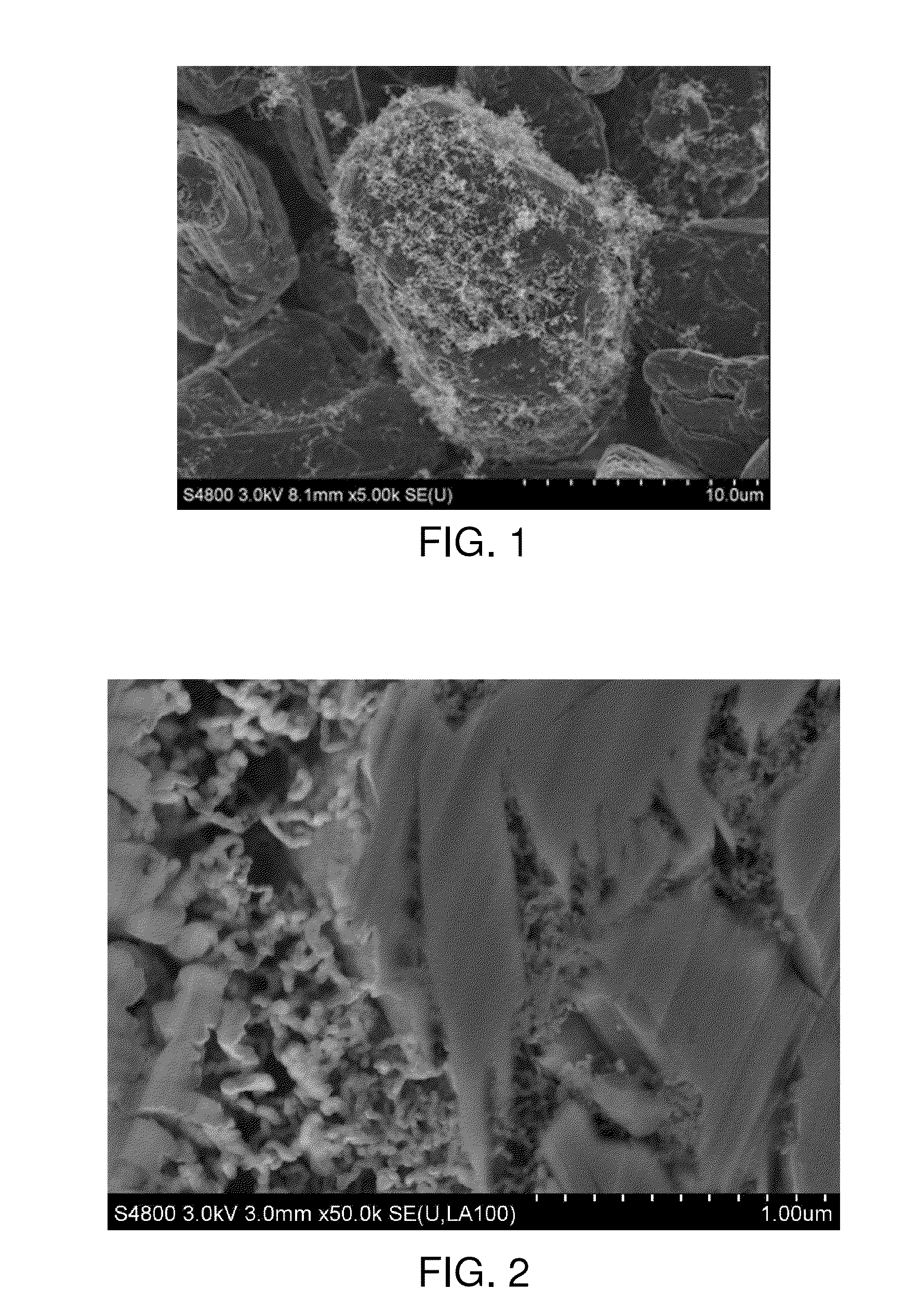Lithium ion battery graphite negative electrode material and preparation method thereof
a technology of graphite and lithium ion batteries, which is applied in the direction of cell components, coatings, chemistry apparatuses and processes, etc., can solve the problems of poor compatibility between natural graphite and electrolytes, graphite layer peeling, and great disadvantage in the cycle stability of batteries, and achieve excellent cycle stability and high rate performance.
- Summary
- Abstract
- Description
- Claims
- Application Information
AI Technical Summary
Benefits of technology
Problems solved by technology
Method used
Image
Examples
example 1
[0072]Natural spherical graphite having a carbon content of more than 85% and a particle size of 3˜40 μm was placed in a VC-500 type mixer. Coal tar pitch was introduced in the mass ratio of 0.5:100 to the natural spherical graphite, to conduct solid-phase mixing with rotational speed of 5000 rpm and mixing time of 5 min, obtaining a mix. The mix was placed in a crucible equipped in a tunnel kiln. The volume of the mix was 50% of the capacity of the crucible. Nitrogen gas was aerated in a flow rate of 10 m3 / h, the temperature was elevated up to 300° C. in a heating rate of 0.1° C. / min, and the heat treatment was conducted for 1 h. The heat-treatment product was placed in a rotatory furnace with a rotational speed of 1 rpm. Nitrogen gas was aerated in a flow rate of 0.05 L / min, the temperature was elevated up to 300° C. in a heating rate of 0.1° C. / min, and maintained for 0.5 h. Then the carbon source gas, that is, natural gas was aerated in a flow rate of 0.05 L / min to perform vapor...
example 2
[0073]Natural flake graphite having a carbon content of more than 85% and a particle size of 3˜40 μm was placed in a VC-500 type mixer. Petroleum asphalt was introduced in the mass ratio of 30:100 to the natural flake graphite, to conduct solid-phase mixing with a rotational speed of 500 rpm and mixing time of 180 min, obtaining a mix. The mix was placed in a crucible equipped in a tunnel kiln. The volume of the mix was 10% of the capacity of the crucible. Nitrogen gas was aerated in a flow rate of 10 m3 / h, the temperature was elevated up to 1300° C. in a heating rate of 20° C. / min, and the heat treatment was conducted for 30 h. The heat-treatment product was placed in a rotatory furnace with a rotational speed of 20 rpm. Nitrogen gas was aerated in a flow rate of 10 L / min, the temperature was elevated up to 1300° C. in heating rate of 50° C. / min, and maintained for 1 h. Then the carbon source gas methane was aerated in a flow rate of 10 L / min to perform vapor deposition for 0.1 h. ...
example 3
[0074]Artificial graphite having a carbon content of more than 85% and a particle size of 3˜40 μm was placed in a VC-150 type mixer. Coal tar pitch was introduced in the mass ratio of 10:100 to the natural flake graphite, to conduct solid-phase mixing with a rotational speed of 3000 rpm and mixing time of 150 min, obtaining a mix. The mix was placed in a crucible equipped in a tunnel kiln. The volume of the mixed material was 50% of the capacity of the crucible. Nitrogen gas was aerated in a flow rate of 5 m3 / h, the temperature was elevated up to 600° C. in a heating rate of 10° C. / min, and the heat treatment was conducted for 10 h. The heat-treatment product was placed in a rotatory furnace with a rotational speed of 10 rpm; nitrogen gas was aerated in a flow rate of 5 L / min. The temperature was elevated up to 900° C. in a heating rate of 25° C. / min, and maintained for 3 h. Then the carbon source gas, that is, acetylene was aerated in a flow rate of 5 L / min to perform vapor deposit...
PUM
| Property | Measurement | Unit |
|---|---|---|
| specific surface area | aaaaa | aaaaa |
| diameter | aaaaa | aaaaa |
| length | aaaaa | aaaaa |
Abstract
Description
Claims
Application Information
 Login to View More
Login to View More - R&D
- Intellectual Property
- Life Sciences
- Materials
- Tech Scout
- Unparalleled Data Quality
- Higher Quality Content
- 60% Fewer Hallucinations
Browse by: Latest US Patents, China's latest patents, Technical Efficacy Thesaurus, Application Domain, Technology Topic, Popular Technical Reports.
© 2025 PatSnap. All rights reserved.Legal|Privacy policy|Modern Slavery Act Transparency Statement|Sitemap|About US| Contact US: help@patsnap.com



